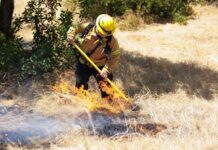Neil Young turns up the volume on latest album
It starts with a jangled mess of a guitar but quickly Neil
Young’s piercing vocals find life and help create an atmospheric
beauty, and Young’s best record in a long, long time.
So let me be the first of many to say
– welcome back Neil Young. You’ve been missed.
Neil Young turns up the volume on latest album
It starts with a jangled mess of a guitar but quickly Neil Young’s piercing vocals find life and help create an atmospheric beauty, and Young’s best record in a long, long time.
So let me be the first of many to say – welcome back Neil Young. You’ve been missed.
Now obviously I wasn’t around when Young was at his best – his greatest achievements are and will always be Harvest and After the Gold Rush and they were made in the 1970s.
But since the early ’90s Young has been musically stuck. Nothing he releases is overly impressive or bad by any means – it’s just there.
Being “there” isn’t necessarily a bad thing – it’s just not a good thing. Albums are unspoken of and remain simply unknown. The quality and sound is a given and doesn’t bring any new excitement.
The albums were stuck in a sort of musical purgatory from which Young couldn’t necessarily escape. A band’s sound should always evolve over time instead of staying in the same headspace. Surprisingly, Young used to be a master at that. In the ’80s, Young was wildly creative, recording an album of digital sounds and promoting the alternative rock scene.
Young was always a musical enigma making each album completely different than the last before the ’90s hit and music starting focusing itself on rap artists such as Eminem and boy bands such as ‘N Sync.
Since that time Young’s sound, whether it’s old age or he has run out of ideas, has stayed the same.
In last year’s Fork in the Road, Young seemed to be at a crossroads at which the album’s title hinted. Young was trying to move forward but too many times the album’s sound was just a reprise of the past.
And then comes this year’s Le Noise. For the first time in a while, Young is by himself with his guitar and not with a band.
The album’s story is this – Young took his guitar to a friend’s studio, Daniel Lanios, and just played new songs off the cuff. No practice and no band. Lanios recorded the album and added effects to the guitar and vocals.
And all of this is immediately noticeable but in the best way possible.
So what makes this album so good? Well it’s the simplicity and its messy guitar is wonderful chaos.
The album blends two distinctive guitar sounds: one, Young’s trademark acoustic folk and the other a grunge-like bluesy slithering guitar. And it’s the more rock-focused guitar that steals the album.
Six of the album’s eight songs belong to the electric-slithering guitar. The songs are slow brooding and heavily blues based.
The recording itself is rather simple but the effects Lanios puts on the guitar add extra layers to a simple sound.
The opening track “Walk With Me” starts with just that messy guitar but using slowed-down guitar effects the song turns into an ambient. It drifts into the next song with a rustled peace. The guitar is still present but it’s not powerful and loud.
It sounds like the noise and sound itself is dying before being swept off to the next. Young wails, “walk with me” and gives his best impression of Robert Plant.
For an artist who is best known for his folk or country songs, the opening is startling but also a clear example of what’s to come.
But that is not to say Young doesn’t go back to his roots.
The song “Love and War” is an acoustic political song that sings of war.
“When I sing about love and war/ I don’t really know what I’m saying/ I’ve been in love and I’ve seen a lot of war/ seen a lot of people praying/ They prayed out and they prayed to the lord/ but mostly they prayed about love and war,” Young sings gently.
The song is the album’s emotional core. It’s the mature moment of the album, as the other seven songs seem like a juvenile brother.
The rest is loud, messy and in your face but “Love and War” is gentle.
“Seen a lot of young man go to war/ and leave a lot of young brides waiting/ I’ve watched them try to explain it to their kids/ and a lot of them failing/ they tried to tell them and tried to explain/ why daddy won’t come home again,” Young sings.
For the first and only time during the record’s 37 minutes Young opens up and it feels meaningful.
Other highlights include the five-minute, hard-rock like “Hitchhiker,” where Young sings about all the things he’s done like smoking through a pen, and the album closer “Rumblin’.”
Overall, Le Noise is a great record that finally finds Young returning to his experimental best after nearly 20 years.
Connor Ramey can be reached at
cr****@sv**********.com
. E-mail him with ideas of albums to review, local musical events or more.







